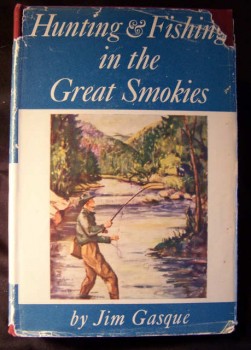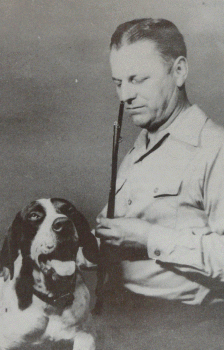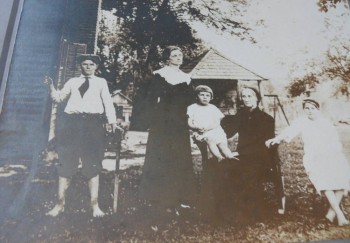Jim Gasque’s Hunting and Fishing in the Great Smokies, first published in 1948, was part of the thirty-one title series “Borzoi Books for Sportsmen” printed by Alfred A. Knopf from 1943 to 1955. This handsomely produced collection of sporting books, with covers of gilt lettering on silk, featured the top outdoor writers of mid-twentieth century America – Jack, O’Connor, Van Campen Heilner, and Ray Bergman to name three.
 Unfortunately, buyers of the Gasque edition were few. Only 2,644 copies were sold and there was no second printing. Some feel the lack of interest in the book was due to the remoteness of the Smokies at the time. Before the interstate highway system was built, the Smokies were nowhere near as accessible. Furthermore, since its designation as a national park in 1934, hunting was no longer allowed there. So the title receded into memory – temporarily.Over time, perhaps due to the popularity of Gasque’s Bass Fishing – Techniques, Tactics, and Tales, sportsmen discovered the book, talked about it, and shared it with their friends. It became a coveted addition to the libraries of many an outdoorsman.
Unfortunately, buyers of the Gasque edition were few. Only 2,644 copies were sold and there was no second printing. Some feel the lack of interest in the book was due to the remoteness of the Smokies at the time. Before the interstate highway system was built, the Smokies were nowhere near as accessible. Furthermore, since its designation as a national park in 1934, hunting was no longer allowed there. So the title receded into memory – temporarily.Over time, perhaps due to the popularity of Gasque’s Bass Fishing – Techniques, Tactics, and Tales, sportsmen discovered the book, talked about it, and shared it with their friends. It became a coveted addition to the libraries of many an outdoorsman.
Finally, in recent years, the University of North Carolina Press reissued Hunting and Fishing in the Great Smokies thus introducing new audiences to this gem. Although published more than sixty years ago, Gasque’s guide to fields, streams, equipment, strategies, and techniques, remains for the most part, spot-on.
The chapters on hooking a trout in Cataloochee Creek, legendary angler Mark Cathey’s final season, the demise of Old Snag the Russian Boar, and the fishhawk that jigged the seven pound bass, sound notes of simplicity and power, surface and meaning, seldom found in the pages of our favorite hunting magazines.
Additionally, the reader of regional history will notice a kinship between this book and another classic book about the Smokies — Horace Kephart’s Our Southern Highlanders. In combination, they present a near seamless timeline of the North Carolina mountains from 1904 through 1948, the period after big dams were built and new lakes such as Santeetlah, Fontana, and Chatuge were formed. Gasque devotes a whole chapter to Lake Chatuge which covers portions of Hayesville, North Carolina and Hiawassee, Georgia. It had been in existence for merely six years when the book was published.
Above all, Hunting and Fishing in the Great Smokies is a celebration of life in the outdoors. Jim Gasque, with his deft touch for phrasing and description, transports the reader to smoky mountain creeks and rocky backcountry, the home of rainbow trout, Russian boar, black bear, and ruffed grouse.
Along the journey, one could not ask for a more affable and entertaining guide.
So who was Jim Gasque?
He was born March 30, 1903 in Morven, North Carolina in the southern central part of the state near the South Carolina border. His father, McRoy, had been a real estate “dealer” and a general store-keeper.
Unfortunately, McRoy had a drinking problem and that is why Jim’s mother, Myrtle Lane, a schoolteacher, left him in 1919 and moved with her two sons and two daughters to Iredell County, North Carolina to be near her brother, James G. Stikeleather. Stikeleather was a founder of the Hazel Creek Fishing and Outing Club. He owned about 7,600 acres in the Hazel Creek area, having purchased it from the W. M. Ritter Lumber Company when they ceased operations there in 1926.
Hunting and Fishing in the Great Smokies is dedicated to a friend from the fishing club, Captain Robert D. Gatewood, a California stockbroker and former naval aide to Woodrow Wilson. Such was the caliber of sportsman you would find in the club. You might encounter a member of the Kress Department Store family; Branch Rickey, President and General Manager of the Brooklyn Dodgers; or famous outdoor writers like George La Branche. Although Hazel Creek was unusual in this way, there were local farmers who fished in the same waters as the “bigwigs.” Sportsmanship and expertise — not social class — was the criteria for acceptance.
So it seems that Gasque came to fly-fishing as a teenager through the kindness of his uncle. The Fishing Club became an important part of his life, not only for the sport, but for the camaraderie – and perhaps, for the abundance of father figures.
Jim did not pursue his education past high school despite the fact his mother was a teacher and his brother, Mac Roy, graduated from the University of Tennessee, flowed by the University of Virginia’s medical school.
Jim first worked in a dry goods store then became part-owner and manager of the Asheville Exterminating Company, a career choice which allowed him flexible hours to hunt and fish. He also ran a fishing guide service for the Asheville Chamber of Commerce.
Eventually, by his early thirties, he began writing outdoor columns for local Asheville newspapers, then articles for national magazines such as Field and Stream and Sports Afield. His first book, Bass Fishing, came out in 1945.
Along the way, Gasque came to make custom fly-rods and flies for Abercrombie and Fitch, and he invented bass lure designs such as the Dubl-Minnow, Gasque Crawler and Bassstriker for manufacture by the Allen Company of Chicago and other companies.
 Although his formal education was limited, as mentioned he was an exceptional writer. Again, one would suspect his schoolteacher mother was an influence. Gaylord Gasque, the author’s nephew, provided me with a hand-written note Jim had enclosed with his mother’s personal copy of Bass Fishing, his first published book:
Although his formal education was limited, as mentioned he was an exceptional writer. Again, one would suspect his schoolteacher mother was an influence. Gaylord Gasque, the author’s nephew, provided me with a hand-written note Jim had enclosed with his mother’s personal copy of Bass Fishing, his first published book:
To my mother whose patience must have been sorely tried in rearing an adventuresome lad whose life was cane poles and air rifles –
Now I look back upon the childhood memories of your love which has followed me through with perfect understanding, and your good wishes have been a source of comfort to me. With love and best wishes. Jim.
So, thanks to a supportive mother and a caring uncle, a fatherless country boy was allowed to seek his true calling and to develop into an extraordinary sportsman and writer. James G. Stikeleather did us all a great favor when he performed a simple yet profound gesture – he took a kid fishing.


